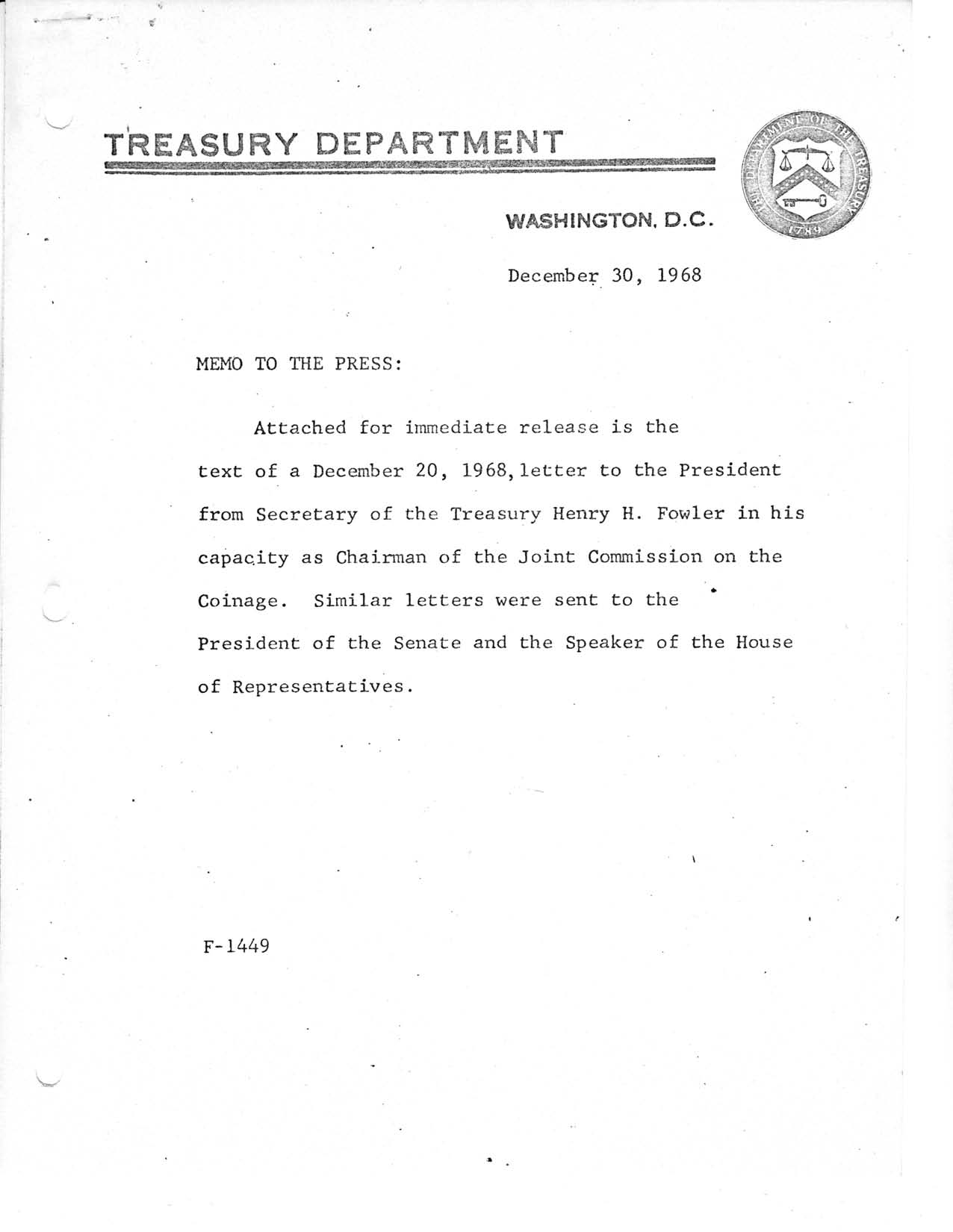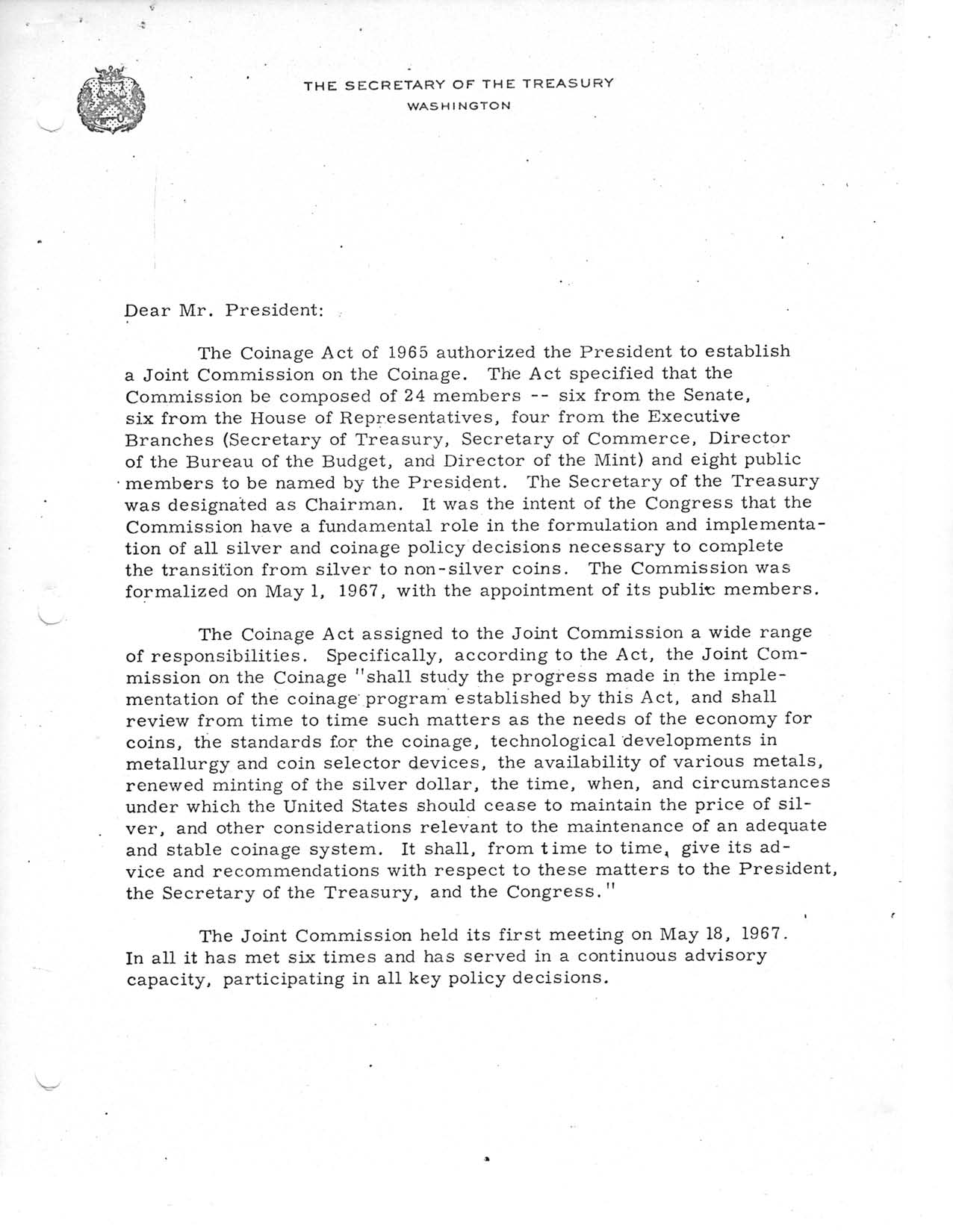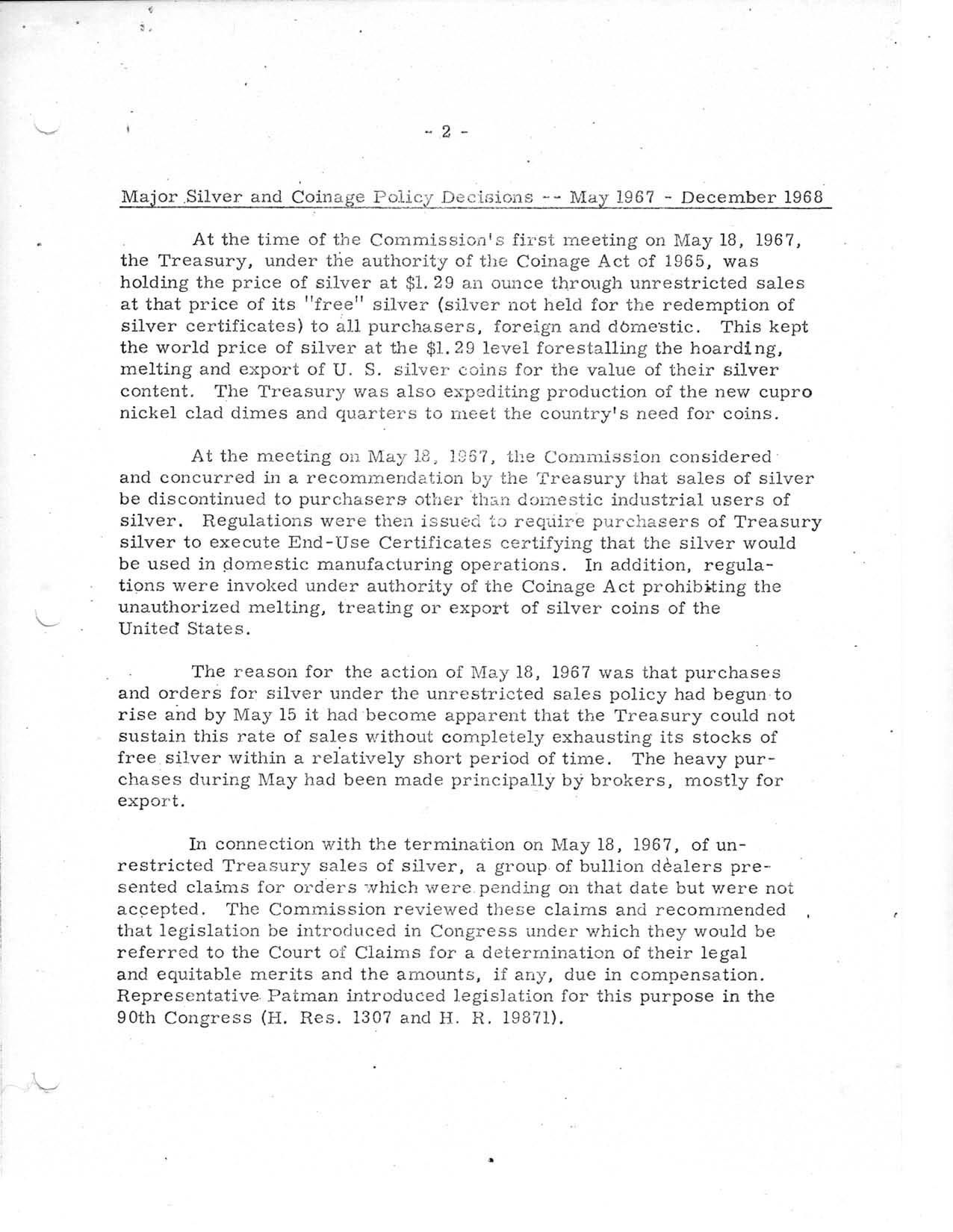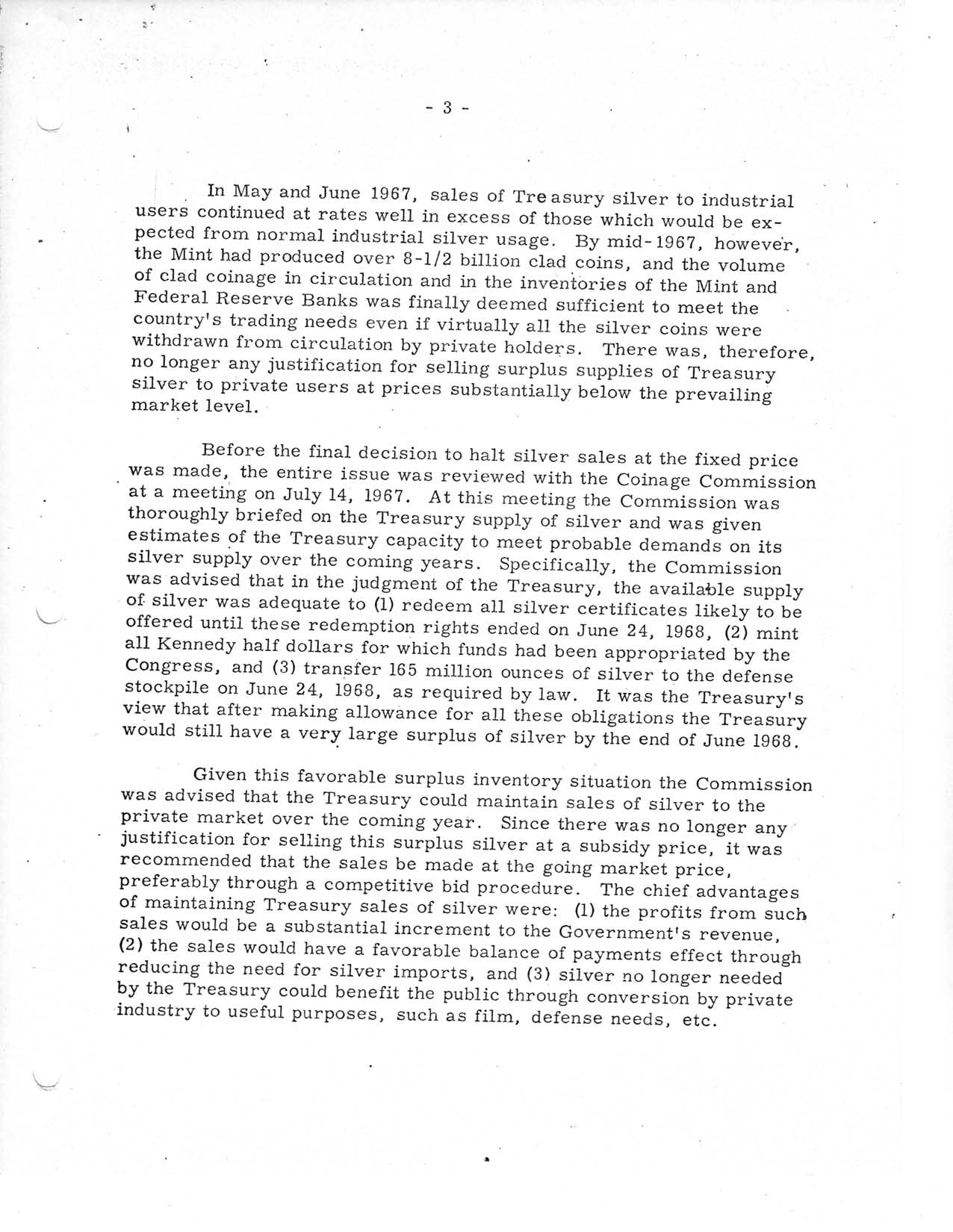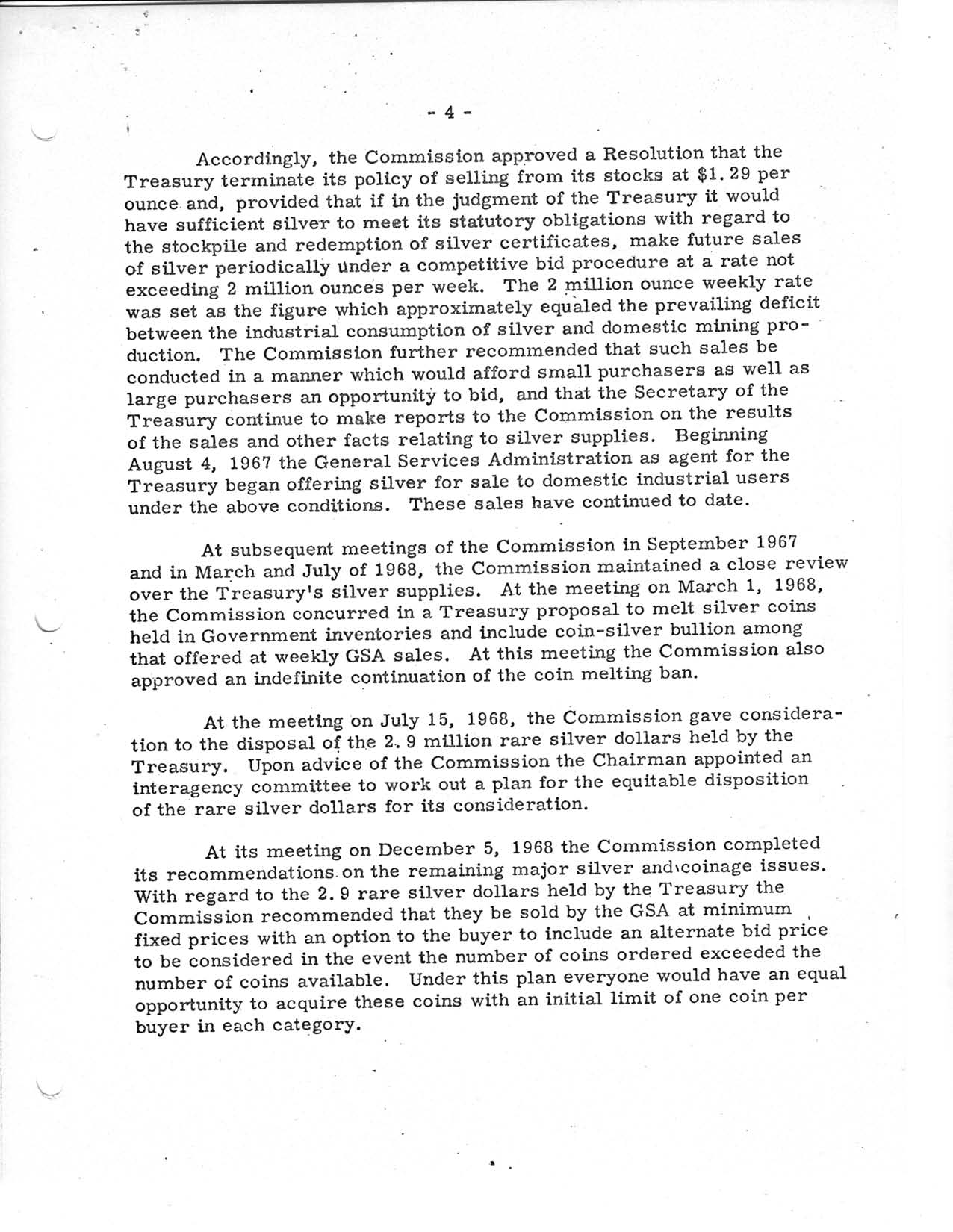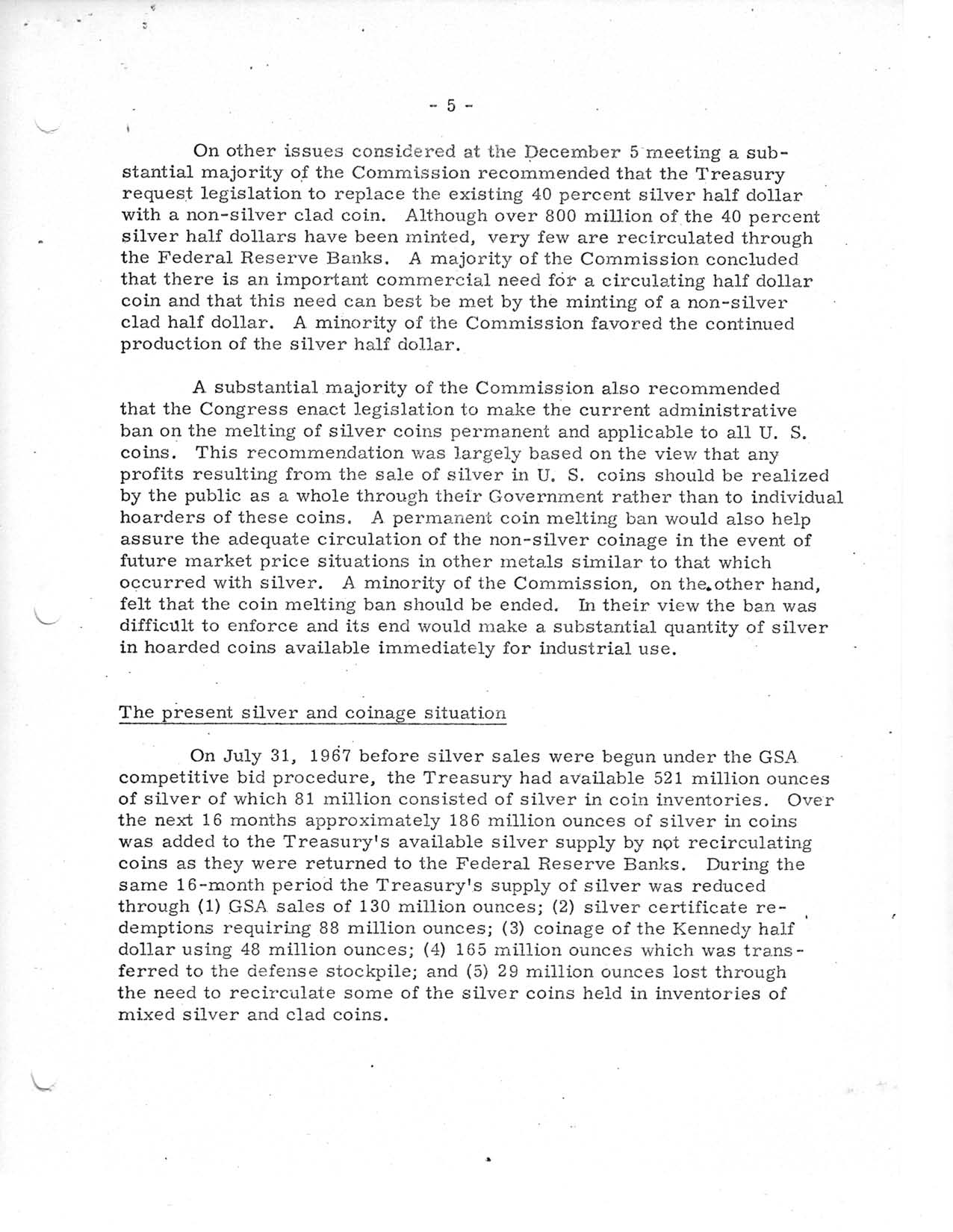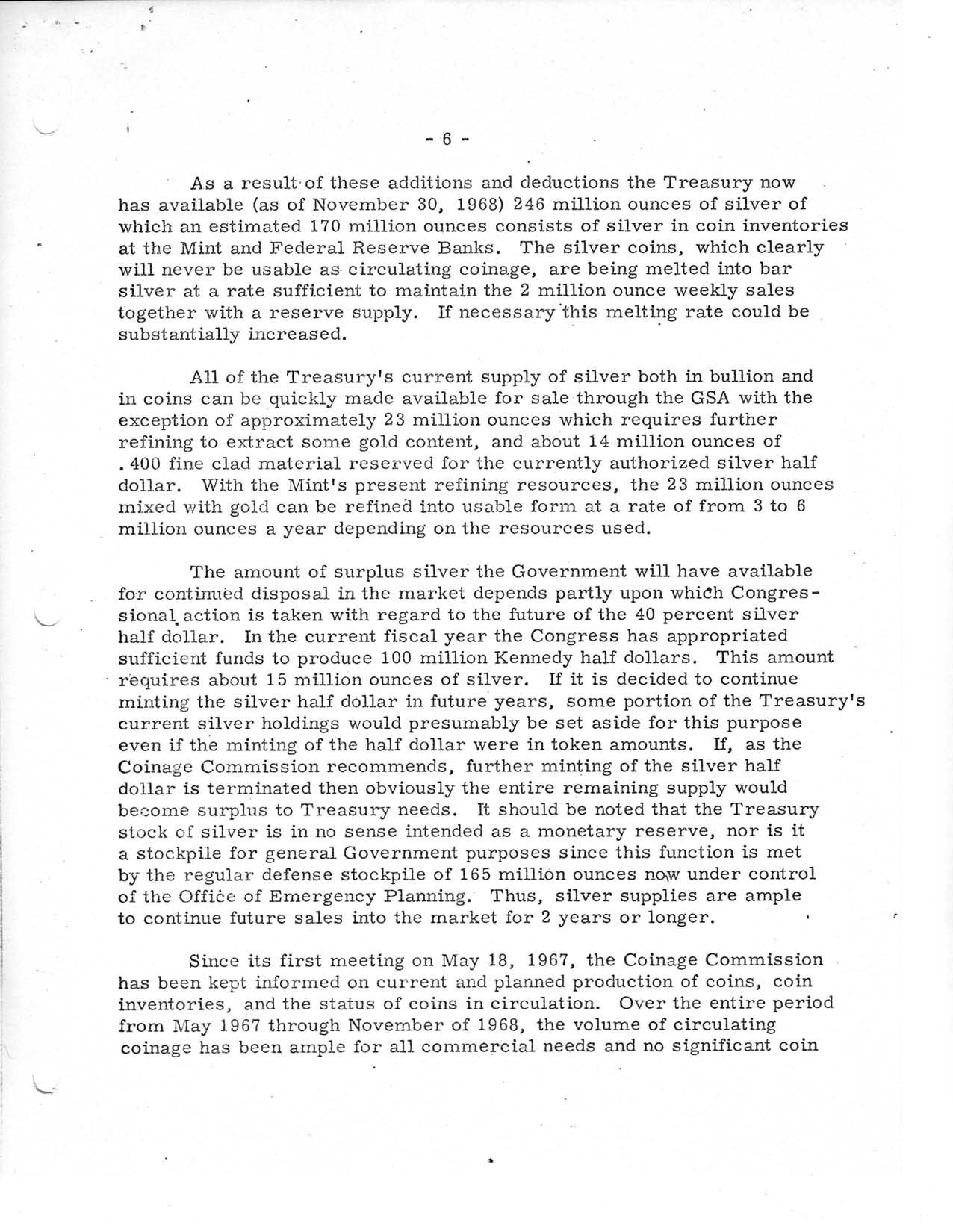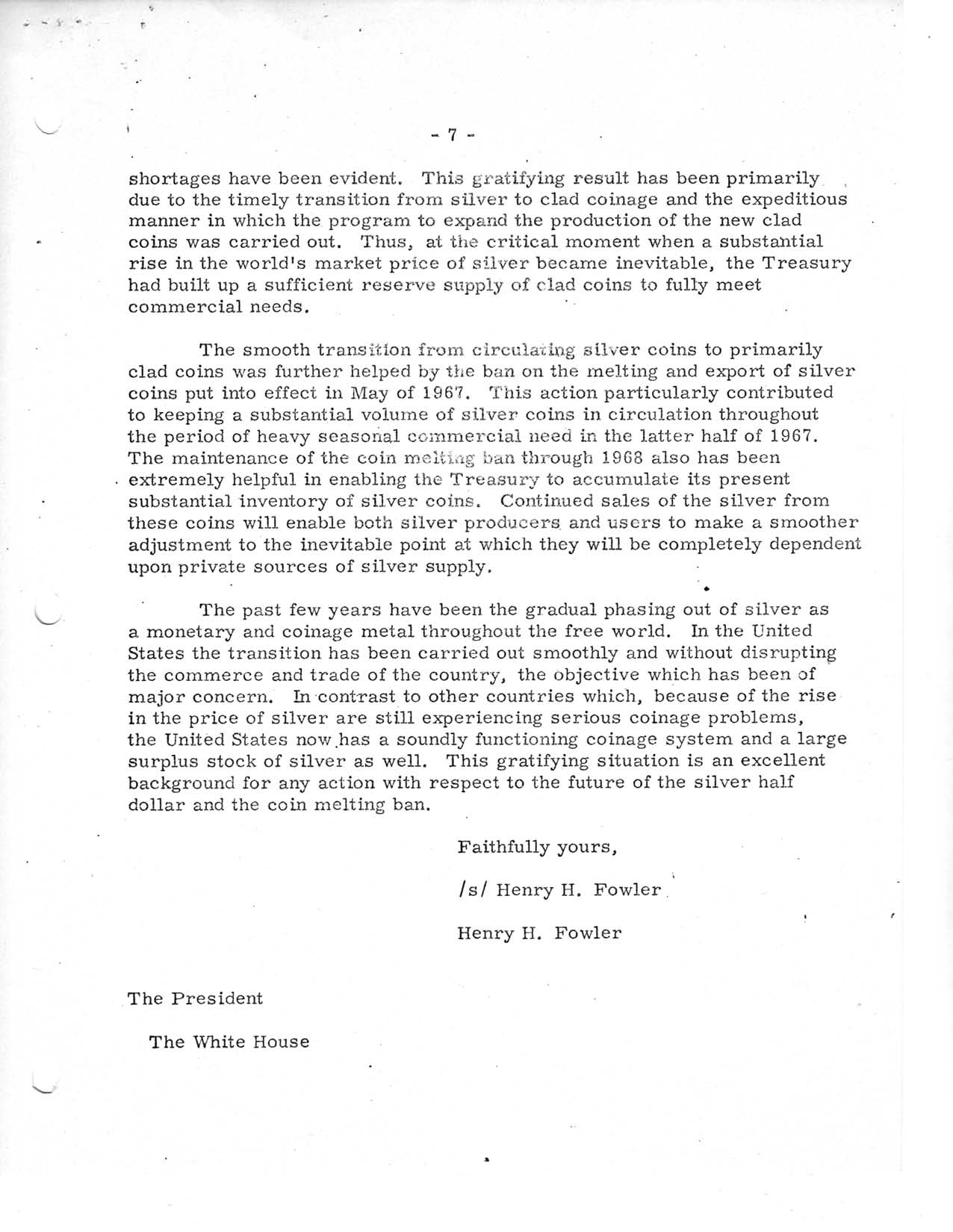Press Release
December 30, 1968
MEMO TO THE PRESS:
Attached for immediate release is the text of a December 20, 1968, letter to the President from Secretary of the Treasury Henry H. Fowler in his capacity as Chairman of the Joint Commission on the Coinage. Similar letters were sent to the President of the Senate and the Speaker of the House of Representatives.
Dear Mr. President:
The Coinage Act of 1965 authorized the President to establish a Joint Commission on the Coinage. The Act specified that the Commission be composed of 24 members—six from the Senate, six from the House of Representatives, four from the Executive Branches (Secretary of Treasury, Secretary of Commerce, Director of the Bureau of the Budget, and Director of the Mint) and eight public members to be named by the President. The Secretary of the Treasury was designated as Chairman. It was the intent of the Congress that the Commission have a fundamental role in the formulation and implementation of all silver and coinage policy decisions necessary to complete the transition from silver to non-silver coins. The Commission was formalized on May 1, 1967, with the appointment of its public members.
The Coinage Act assigned to the Joint Commission a wide range of responsibilities. Specifically, according to the Act, the Joint Commission on the Coinage “shall study the progress made in the implementation of the coinage program established by this Act, and shall review from time to time such matters as the needs of the economy for coins, the standards for the coinage, technological developments in metallurgy and coin selector devices, the availability of various metals, renewed minting of the silver dollar, the time, when, and circumstances under which the United States should cease to maintain the price of silver, and other considerations relevant to the maintenance of an adequate and stable coinage system. It shall, from time to time, give its advice and recommendations with respect to these matters to the President, the Secretary of the Treasury, and the Congress.”
The Joint Commission held its first meeting on May 18, 1967. In all it has met six times and has served in a continuous advisory capacity, participating in all key policy decisions.
Major Silver and Coinage Policy Decisions — May 1967 – December 1968
At the time of the Commission’s first meeting on May 18, 1967, the Treasury, under the authority of the Coinage Act of 1965, was holding the price of silver at $1. 29 an ounce through unrestricted sales at that price of its “free” silver (silver not held for the redemption of silver certificates) to all purchasers, foreign and domestic. This kept the world price of silver at the $1. 29 level forestalling the hoarding, melting and export of U. S. silver coins for the value of their silver content. The Treasury was also expediting production of the new cupro nickel clad dimes and quarters to meet the country’s need for coins.
At the meeting on May 18, 1967, the Commission considered and concurred in a recommendation by the Treasury that sales of silver be discontinued to purchasers other than domestic industrial users of silver. Regulations were then issued to required purchasers of Treasury silver to execute End-Use Certificates certifying that the silver would be used in domestic manufacturing operations. In addition, regulations were invoked under authority of the Coinage Act prohibiting the unauthorized melting, treating or export of silver coins of the United States.
The reason for the action of May 18, 1967 was that purchases and orders for silver under the unrestricted sales policy had begun to rise and by May 15 it had become apparent that the Treasury could not sustain this rate of sales without completely exhausting its stocks of free silver within a relatively short period of time. The heavy purchases during May had been made principally by brokers, mostly for export.
In connection with the termination on May 18, 1967, of unrestricted Treasury sales of silver, a group of bullion dealers presented claims for orders which were pending on that date but were not accepted. The Commission reviewed these claims and recommended that legislation be introduced in Congress under which they would be referred to the Court of Claims for a determination of their legal and equitable merits and the amounts, if any, due in compensation. Representative Patman introduced legislation for this purpose in the 90th Congress (H. Res. 1307 and H. R. 19871).
In May and June 1967, sales of Treasury silver to industrial users continued at rates well in excess of those which would be expected from normal industrial silver usage. By mid-1967, however, the Mint had produced over 8-1/2 billion clad coins, and the volume of clad coinage in circulation and in the inventories of the Mint and Federal Reserve Banks was finally deemed sufficient to meet the country’s trading needs even if virtually all the silver coins were withdrawn from circulation by private holders. There was, therefore, no longer any justification for selling surplus supplies of Treasury silver to private users at prices substantially below the prevailing market level.
Before the final decision to halt silver sales at the fixed price was made, the entire issue was reviewed with the Coinage Commission at a meeting on July 14, 1967. At this meeting the Commission was thoroughly briefed on the Treasury supply of silver and was given estimates of the Treasury capacity to meet probable demands on its silver supply over the coming years. Specifically, the Commission was advised that in the judgment of the Treasury, the available supply of silver was adequate to (1) redeem all silver certificates likely to be offered until these redemption rights ended on June 24, 1968, (2) mint all Kennedy half dollars for which funds had been appropriated by the Congress, and (3) transfer 165 million ounces of silver to the defense stockpile on June 24, 1968, as required by law. It was the Treasury’s view that after making allowance for all these obligations the Treasury would still have a very large surplus of silver by the end of June 1968.
Given this favorable surplus inventory situation the Commission was advised that the Treasury could maintain sales of silver to the private market over the coming year. Since there was no longer any justification for selling this surplus silver at a subsidy price, it was recommended that the sales be made at the going market price, preferably through a competitive bid procedure. The chief advantages of maintaining Treasury sales of silver were: (1) the profits from such sales would be a substantial increment to the Government’s revenue, (2) the sales would have a favorable balance of payments effect through reducing the need for silver imports, and (3) silver no longer needed by the Treasury could benefit the public through conversion by private industry to useful purposes, such as film, defense needs, etc.
Accordingly, the Commission approved a Resolution that the Treasury terminate its policy of selling from its stocks at $1.29 per ounce and, provided that if in the judgment of the Treasury it would have sufficient silver to meet its statutory obligations with regard to the stockpile and redemption of silver certificates, make future sales of silver periodically under a competitive bid procedure at a rate not exceeding 2 million ounces per week. The 2 million ounce weekly rate was set as the figure which approximately equaled the prevailing deficit between the industrial consumption of silver and domestic mining production. The Commission further recommended that such sales be conducted in a manner which would afford small purchasers as well as large purchasers an opportunity to bid, and that the Secretary of the Treasury continue to make reports to the Commission on the results of the sales and other facts relating to silver supplies. Beginning August 4, 1967 the General Services Administration as agent for the Treasury began offering silver for sale to domestic industrial users under the above conditions. These sales have continued to date.
At subsequent meetings of the Commission in September 1967 and in March and July of 1968, the Commission maintained a close review over the Treasury’s silver supplies. At the meeting on March 1, 1968, the Commission concurred in a Treasury proposal to melt silver coins held in Government inventories and include coin-silver bullion among that offered at weekly GSA sales. At this meeting the Commission also approved an indefinite continuation of the coin melting ban.
At the meeting on July 15, 1968, the Commission gave consideration to the disposal of the 2.9 million rare silver dollars held by the Treasury. Upon advice of the Commission the Chairman appointed an interagency committee to work out a plan for the equitable disposition of the rare silver dollars for its consideration.
At its meeting on December 5, 1968 the Commission completed its recommendations on the remaining major silver and coinage issues. With regard to the 2.9 rare silver dollars held by the Treasury the Commission recommended that they be sold by the GSA at minimum fixed prices with an option to the buyer to include an alternate bid price to be considered in the event the number of coins ordered exceeded the number of coins available. Under this plan everyone would have an equal opportunity to acquire these coins with an initial limit of one coin per buyer in each category.
On other issues considered at the December 5 meeting a substantial majority of the Commission recommended that the Treasury request legislation to replace the existing 40 percent silver half dollar with a non-silver clad coin. Although over 800 million of the 40 percent silver half dollars have been minted, very few are recirculated through the Federal Reserve Banks. A majority of the Commission concluded that there is an important commercial need for a circulating half dollar coin and that this need can best be met by the minting of a non-silver clad half dollar. A majority of the Commission favored the continued production of the silver half dollar.
A substantial majority of the Commission also recommended that the Congress enact legislation to make the current administrative ban on the melting of silver coins permanent and applicable to all U.S. coins. This recommendation was largely based on the view that any profits resulting from the sale of silver in U.S. coins should be realized by the public as a whole through their Government rather than to individual hoarders of these coins. A permanent coin melting ban would also help assure the adequate circulation of the non-silver coinage in the event of future market price situations in other metals similar to that which occurred with silver. A minority of the Commission, on the other hand, felt that the coin melting ban should be ended. In their view the ban was difficult to enforce and its end would make a substantial quantity of silver in hoarded coins available immediately for industrial use.
The present silver and coinage situation
On July 31, 1967 before silver sales were begun under the GSA competitive bid procedure, the Treasury had available 521 million ounces of silver of which 81 million consisted of silver in coin inventories. Over the next 16 months approximately 186 million ounces of silver in coins was added to the Treasury’s available silver supply by not recirculating coins as they were returned to the Federal Reserve Banks. During the same 16-month period the Treasury’s supply of silver was reduced through (1) GSA sales of 130 million ounces; (2) silver certificate redemptions requiring 88 million ounces; (3) coinage of the Kennedy half dollar using 48 million ounces; (4) 165 million ounces which was transferred to the defense stockpile; and (5) 29 million ounces lost through the need to recirculate some of the silver coins held in inventories of mixed silver and clad coins.
As a result of these additions and deductions the Treasury now has available (as of November 30, 1968) 246 million ounces of silver which an estimated 170 million ounces consists of silver in coin inventories at the Mint and Federal Reserve Banks. The silver coins, which clearly will never be usable as circulating coinage, are being melted into bar silver at a rate sufficient to maintain the 2 million ounce weekly sales together with a reserve supply. If necessary this melting rate could be substantially increased.
All of the Treasury’s current supply of silver both in bullion and in coins can be quickly made available for sale through the GSA with the exception of approximately 23 million ounces which requires further refining to extract some gold content, and about 14 million ounces of .400 fine clad material reserved for the currently authorized silver half dollar. With the Mint’s present refining resources, the 23 million ounces mixed with gold can be refined into usable form at a rate of from 3 to 6 million ounces a year depending on the resources used.
The amount of surplus silver the Government will have available for continued disposal in the market depends partly upon which Congressional action is taken with regard to the future of the 40 percent silver half dollar. In the current fiscal year the Congress has appropriated sufficient funds to produce 100 million Kennedy half dollars. This amount requires about 15 million ounces of silver. If it is decided to continue minting the silver half dollar in future years, some portion of the Treasury’s current silver holdings would presumably be set aside for this purpose even if the minting of the half dollar were in token amounts. If, as the Coinage Commission recommends, further minting of the silver half dollar is terminated then obviously the entire remaining supply would become surplus to Treasury needs. It should be noted that the Treasury stock of silver is in no sense intended as a monetary reserve, nor is it a stockpile for general Government purposes since this function is met by the regular defense stockpile of 165 million ounces now under control of the Office of Emergency Planning. Thus, silver supplies are ample to continue future sales into the market for 2 years or longer.
Since its first meeting on May 18, 1967, the Coinage Commission has been kept informed on current and planned production of coins, coin inventories, and the status of coins in circulation. Over the entire period from May 1967 through November of 1968, the volume of circulating coinage has been ample for all commercial needs and no significant coin shortages have been evident. This gratifying result has been primarily due to the timely transition from silver to clad coinage and the expeditious manner in which the program to expand the production of the new clad coins was carried out. Thus, at the critical moment when a substantial rise in the world’s market price of silver became inevitable, the Treasury had built up a sufficient reserve supply of clad coins to fully meet commercial needs.
The smooth transition from circulating silver coins to primarily clad coins was further helped by the ban on the melting and export of silver coins put into effect in May of 1967. This action particularly contributed to keeping a substantial volume of silver coins in circulation throughout the period of heavy seasonal commercial need in the latter half of 1967. The maintenance of the coin melting ban through 1968 also has been extremely helpful in enabling the Treasury to accumulate its present substantial inventory of silver coins. Continued sales of the silver from these coins will enable both silver producers and users to make a smoother adjustment to the inevitable point at which they will be completely dependent upon private sources of silver supply.
The past few years have been the gradual phasing out of silver as a monetary and coinage metal throughout the free world. In the United States the transition has been carried out smoothly and without disrupting the commerce and trade of the country, the objective which has been of major concern. In contrast to other countries which, because of the rise in the price of silver are still experiencing serious coinage problems, the United States now has a soundly functioning coinage system and a large surplus stock of silver as well. This gratifying situation is an excellent background for any action with respect to the future of the silver half dollar and the coin melting ban.
Faithfully yours,
/s/ Henry H. Fowler
Henry H. Fowler
The President
The White House



